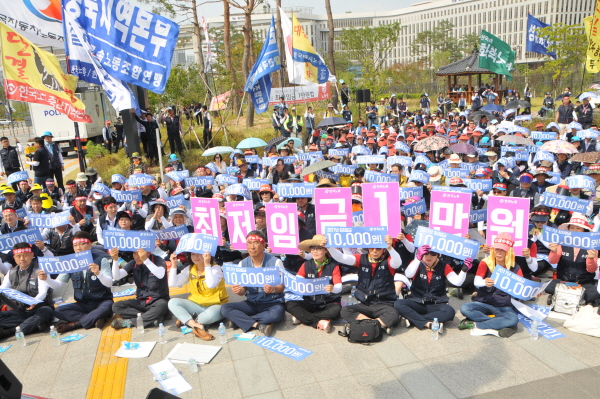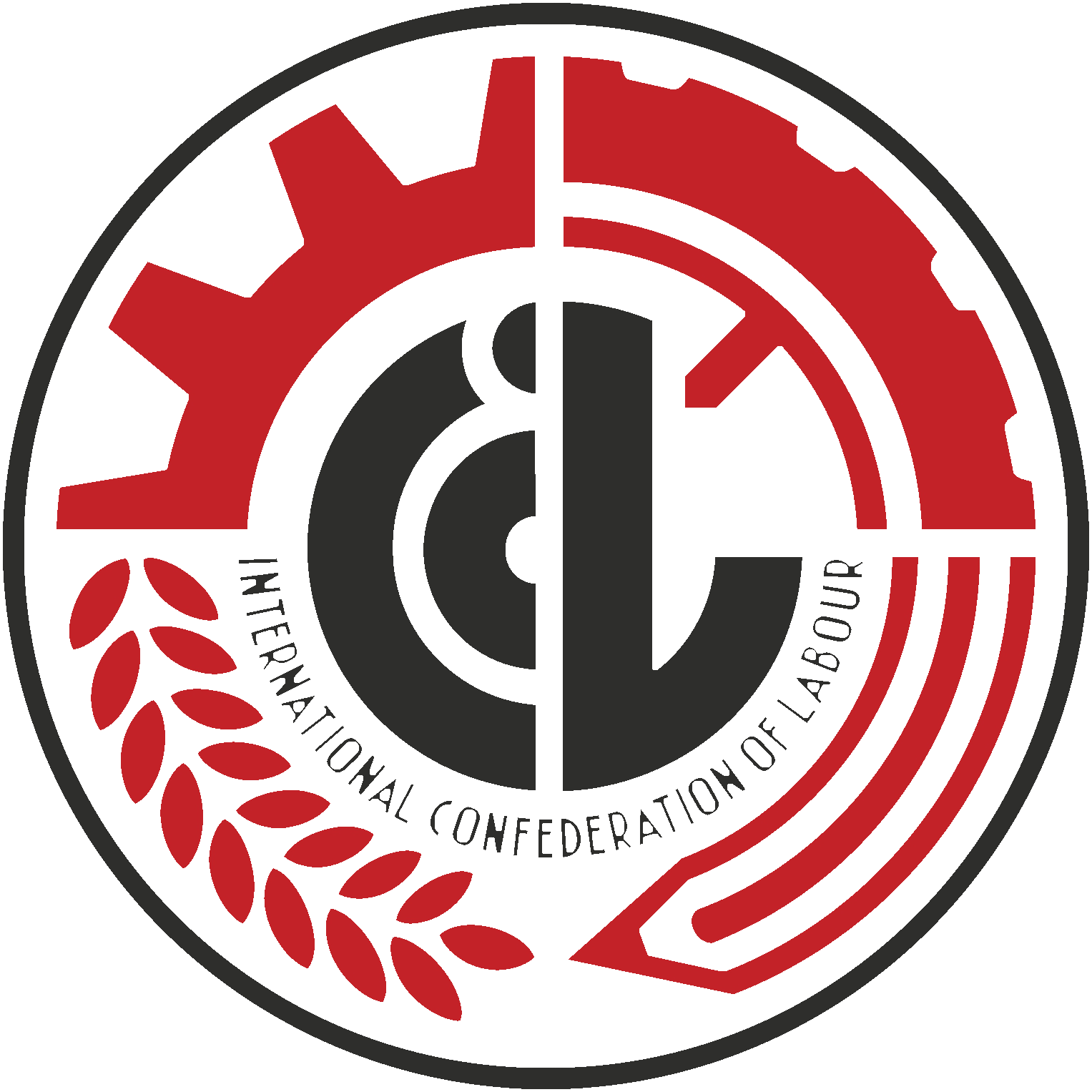LOW UNION MEMBERSHIP
There are only two legal unions in South Korea. The larger one, usually regarded as more moderate, is the Federation of Korean Trade Unions, FKTU. It claims 954,546 members in 2018 and was founded in 1961.
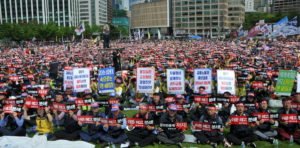 Second largest is the Korean Confederation of Trade Unions, KCTU, with 786,563 members. Due to the circumstances of its foundation and its ethos, it is the most radical of the two.
Second largest is the Korean Confederation of Trade Unions, KCTU, with 786,563 members. Due to the circumstances of its foundation and its ethos, it is the most radical of the two.
There are also some 265,000 workers in other company specific independent unions.
As we’ll see throughout this dossier, the South Korean state has heavily repressed unions, historically. This has caused them to have a very small bargaining capacity. Together with the prevalent ideology of Korean nationalism, this goes a long way to explain the low union membership. It peaked at 20% in 1989, but is now a mere 10% of the workforce. This means that, in a country with a population of 51 million, barely 2 million workers are members of any union whatsoever. A lower rate even than what is found in the European countries with the lowest of all union membership rates (e.g. this rate stands at 18% in Spain).
LATE INDUSTIALISATION
Up to the twentieth century, Korea was referred to as the “hermit kingdom”, due to its political and cultural isolation, not only with regards to European colonial presence, but also to its own immediate neighbours. The only relevant influence was from China, thanks to a Confucian aristocracy that strived to imitate the administrative structure of that country.
This seclusion was partially a response to relentless harassment by Japan, that constantly tried to invade the peninsula from the sea.
Because of its isolation, the traditional structure of Korean society included a 40% of members of the nobi class, living in close-to-slavery conditions (akin to feudal serfs), another 40% of peasants and small-lease holders, and a 20% of the yangban class (government bureaucrats, themselves divided in 18 levels of hierarchy). It was an agrarian country, sparsely industrialised and with feudal economic and social structures.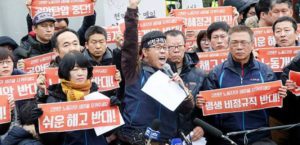
The Gwammu reforms tried to modernise and liberalise the country, in line with Western powers. The yangban class and serfdom were abolished, and an incipient industrialisation took hold. The Korean elite had been progressively distancing themselves from the Chinese influence and moving towards a more pro-Japanese frame of mind. They considered this country’s Western-like reforms and economic modernisation as a reference. This interest resulted in an increasing Japanese influence over the peninsula to the extent that, under the excuse of forming a dependant state, in the context of the 1905 war against Russia, Japan declared Korea a protectorate of its own.
It was under Japanese rule that the reforms and the industrialisation process were set on a firm footing. To the extent that, in 1931, of the 1.2 million acres of land in the hands of large land owners, 0.9 of these were controlled by the Japanese.
As such, the first union in Korea was formed in 1910 by 47 dock workers in Seongjin. However, industrialisation took hold only partially and the development of a workers’ movement was also slow. By the beginning of the 1920s there were only some thirty small unions, bringing together no more than 5,000 members. But from that moment on, this number grew steadily and by 1928 there were 488 unions with nearly 70,000 members. These began to form larger confederations of unions, by trade or geographical area, and had socialist revolutionary or nationalist (opposed to Japanese rule) positions. However, this movement was halted in the 1930s, when Japan began its imperialist expansion and the local administration started persecuting trade unions in earnest. Union members often joined the underground opposition and national liberation movements.
UNIONISM AT THE BATTLE FRONT
After the end of the Second World War, Korean trade unionism was reorganised, in 1945, in a General Council of Korean Trade Unions (GCKTU), which had half a million members. However, soon after, in the context of the Korean War, this union was persecuted in the South, as part of the anti-communist policy of the US military authority. It was subsequently outlawed by the government of the newly formed Republic of Korea in 1948. The GCKTU still is the single trade union in North Korea.
What remained of that union was reorganized by the government that emerged from the coup d’état of May 16, 1961, which would keep South Korea under military rule until 1987. The newly formed union, the FKTU, played the role of an almost vertical union (organized by the State and the bosses).
It is during this period of military rule that the so-called “South Korean economic miracle” took place. In only thirty years, the country went from being mostly agrarian to becoming an industrial powerhouse. Paradoxically, this figurehead of the capitalist world developed thanks to a strict state intervention, that placed companies under direct control by the military administration, through three consecutive five-year plans.
This fast industrialization involved a massive rural exodus and the formation of new layers of the working class. This was especially true for young women, who came from the countryside to the city in droves and were integrated in the new industries. As a result, a new union movement emerged on the side-lines of the official FKTU. The conflicts increased rapidly, as evidenced by the Hyundai workers’ strike of 1974.
As had happened in other countries, the workers’ movement converged with the democratic opposition movements. In 1979, Park Chung-hee, the dictator, was murdered and a transition government was created. However, South Korea had its own involution and a new successful military coup delayed the arrival of democracy until 1987. That year, the repressive regime of Chun Doo-hwan was overthrown, precisely through massive protests by the workers’ movement.
1987 was a key year for the Korean workers’ movement. Many underground unions developed around that time and this resulted in more than 3,300 strikes being called in that year alone. The might of the workers’ movement was thus directed to support the demands for democracy, forcing the military to call elections. However, in 1988 these were won by the right. This meant that the transition to democracy didn’t represent a clean break with the previous regime (similar to what happened during the so-called Spanish Transition). The repression against the workers’ movement continued as well, and around 4,000 union members were sent to prison between 1987 and 1995.
This union movement, independent from the FKTU, led to the formation of the KCTU in 1995. However, it wasn’t officially recognized by the government until 1999. It started as a small union (less than 200,000 members in its beginning) but has been gradually gaining ground to the main state-sponsored union.
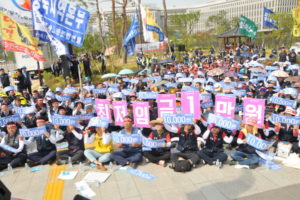 It must be remembered that the Korean peninsula was a hot spot during the Cold War. This caused unionism to be always under government surveillance. With the excuse of the communist threat posed by the North (the two countries haven’t signed a peace agreement yet) the state repressed the trade union movement. The labour movement, together with the left in general, have always represented for the South Korean authorities some sort of “internal enemy”, that had to be kept under control.
It must be remembered that the Korean peninsula was a hot spot during the Cold War. This caused unionism to be always under government surveillance. With the excuse of the communist threat posed by the North (the two countries haven’t signed a peace agreement yet) the state repressed the trade union movement. The labour movement, together with the left in general, have always represented for the South Korean authorities some sort of “internal enemy”, that had to be kept under control.
Currently, unions are growing at the same pace as the economy. Korean nationalism, very present in society and linked to large industrial conglomerates (chaebols), causes any criticism of employers’ organisations or the government to be perceived as a lack of patriotism. This limits the possibilities of the workers to articulate demands. In recent decades, however, the FKTU and the KCTU have been getting closer to each other. The first organisation has been forced to increase its militancy, in response to competition from the second one, which in turn has become more bureaucratic over the years.
LABOUR RELATIONS AND BUSINESS UNIONS
If South Korea took a lead in economic development in Asia, it was at the cost of naked exploitation. Until 2018 the working week was 68 hours. There is hardly any unemployment in the country, but it is the first in the OECD in suicide rates (third for males, first for females). Currently, the working week has been reduced to 52 hours (40 regular hours + 12 overtime). However, the practice of never leaving the job before the boss is prevalent. This often causes workers to not even return home at night, if they happen to live far away from the workplace. In turn, public bathhouses -called jimjilbang– that stay open all night and have sleeping quarters, have proliferated, as well as alcoholism.
The culture of hard work, often to exhaustion, analysed by philosophers such as Byung-Chul Han in his book The Society of Fatigue, begins practically at birth. It is perpetuated by an education system that fosters extreme competition and sacrifice and could be behind the previously mentioned suicide rates.
The minimum working age is 15. A typical working day often reaches up to 12 hours and it is possible to work for four weeks in a row, without a single day off.
Legally, only employed workers can join a union. Most recently, this caused the teachers’ union to be banned in 2013, as it allowed education professionals who had been dismissed or had retired to become members. The ILO criticised this ban, as it went against its agreements.
Unionism is allowed in South Korea only as long as it limits itself to negotiating the price of labour. Any attempt to create a genuine working-class union is banned. Any union that states its will for political transformation is persecuted. As a result, the prevailing model is based on business unions. Syndicalists work closely with company management, but solidarity between different sectors or geographical areas is scarce. Similarly, collective bargaining takes place almost exclusively within large companies.
South Korea acknowledges union hours, but these must be agreed with the employer and are never paid by the company. Even the so-called “full-time officers” (full-timers) are paid exclusively from the union’s own funds, in contrast to other systems in other countries, in which these are paid by the companies. That is, either syndicalists in South Korea do not receive any payment for their role in the workplace or get it from the union, but never from companies or from the government, as is the case in other countries. In a sense, this is positive, as it favours their independence, but is also a sign of the low social status that unions have in the country, compared to the so-called European social states.
Regarding union methods, no strategy involving a “breach of public order” is legally allowed. Equally, any action has to be directly called by a legal union and it can’t include blocking the access to the company or circulation in its premises. This means, in fact, that picketing, which is an important part of union activities in many countries around the world, is banned in South Korea.
Striking is a legally recognized right but it is heavily restricted, both in the requirements to call a strike and in its development. Lockouts, which in many countries are limited to exceptional situations of violence or illegal occupation, are a common practice in South Korea and can be used against any labour demands presented by workers. Scabbing is also frequent.
Despite all the limitations facing the labour movement, this often simply ignores the laws. It is not uncommon for the police to attack strikers, when their struggle becomes particularly powerful.
FKTU AND KCTU: TWO MODELS
KCTU’s growth over the last decades and the fall in membership in the state sponsored union has meant that there currently are two well stablished models in South Korea.
FKTU is more prone to work jointly with company management. It also tends to focus its demands on wage improvement and equalization. However, it has recently taken a critical stand of the government, because of its position against workers’ rights, as set forth by the ILO. FKTU does not have any revolutionary aims, not even reformist ones. They only hope to achieve a labour relations framework similar to what is found in Western Europe. Currently, its president is Kim Juyoung, elected in 2017.
KCTU, on the other hand, represents a more radical option. It was born out of the underground movement and resistance against dictatorship. It states the social and political transformation of South Korea among its aims: it stands for democratization of the industry, gender equality within the company, shortening of the working day and the construction of internationalist unionism. In a country like South Korea, where the minutest reference to socialism is stigmatised and considered a collusion with the North, its discourse can’t go much further, at least explicitly. Its current president is Kim Myung-hwan, after its former leader, Han Sang-gyun, was sent to prison (he was released this year after serving two years, five months and 12 days for public disorder during a protest against government corruption). It is worth noting that KCTU agreed this year to take part in the joint employer-union-government body, which it had rejected since 1999 because of disagreements with the labour law.
Due to the limitations of Korean unionism to go beyond labour demands, it is not strange that union activists end up drifting towards civil rights, feminist or political movements.
INTERNATIONAL RELATIONS
Both the FKTU and the KCTU are part of the International Trade Union Confederation, which includes organisations like UGT and CCOO in Spain, the TUC in the UK and AFL-CIO in the US. However, they also have privileged contacts with other unions from the Pacific area, especially with the Australian trade union movement, which has often shown its solidarity with the South Korean workers. The ITUC itself has on more than one occasion called on the Korean government to stop persecuting trade unionists.
The FKTU is also part of Industrial, an international organisation founded in 2012 that brings together 600 unions from 140 countries, active in the manufacturing industry.
In any case, neither of the two unions have strong developed international links, outside of their geographical area. And the problem in South Korea, of a lack of trade union freedom, is poorly known in many Western countries. Meanwhile, the image usually portrayed in the mass media is of a country that is an example for economic development, especially in contrast to the totalitarian dictatorship of the North.
FINAL CONSIDERATIONS
South Korean unions have managed to endure, despite constant persecution, for more than a century, by Japanese imperialists, the US occupation, military dictators or democratic parties. There are not that many places in the world where union freedoms and the right of the workers to organize are as restricted as in this country. In spite of this, every strike carried out by South Korean unionists is an example of militancy for the rest of the workers worldwide.
The largest threat to South Korean unions is nationalist ideology, that is being constantly promoted by the government and corporations. Its aim is to get workers to internalise the interests of the capitalists as if they were their own. At the same time, a cultural paradigm in which 70% of Koreans consider themselves to be part of the middle class, despite the fact that only 20% of them are liberal professionals and small entrepreneurs, has become pervasive. A working class that falls for these ideological traps is a challenge that all the unions in the world have to face. But in the case of South Korea it is especially pressing.
In a country where exploitation reaches the level of self-harm, where nothing ever stops until workers are exhausted, a determined class unionism, bent on sapping the crudest of neoliberalisms, is utterly required. South Korean workers ended dictatorship. With their might, real social change could be achieved.
Ii would be very interesting for ICL to open up lines of communication with Korean trade unions. Their origins and traditions are far removed from the revolutionary syndicalist or anarcho-syndicalist currents that developed in Europe and America. But their militancy has been tested many times, through decades of repression, massacres and police persecution. There is a lot that we can learn from each other.
BIBLIOGRAPHY
This is certainly no academic exhaustive bibliography. However it may be, below is the list of references used in the report.
- http://fktu.or.kr/
- http://www.kctu.org/
- http://english.hani.co.kr/arti/english_edition/e_national/828667.html
- https://www.koreatimes.co.kr/www/nation/2018/05/371_246755.html
- http://www.industriall-union.org/korean-union-leader-han-sang-gyun-released-from-prison
- Trade Union and Labour Relations Adjustment Act, Act No. 5310, Mar. 13, 1997
- Kwon Seung-ho & Chris Leggett (1995) Origins of the Korean Labour Movement, Policy, Organisation and Society, 1995
- Keun Song, Labour unions in the Republic of Korea: Challenge and choice, Department of Sociology, Seoul National University, 1999
- Ho Keun Song, Labour unions in the Republic of Korea: Challenge and choice, Department of Sociology, Seoul National University, 1999
- https://apuntesdeclase.lamarea.com/protagonistas/corea-del-sur-infierno-laboral/
- https://www.regeneracionlibertaria.org/historia-de-corea-i-epoca-preindustrial
Also available in:
 Español (Spanish)
Español (Spanish)



